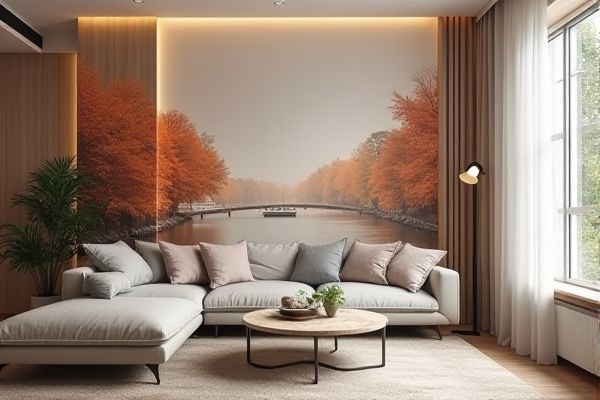
Choosing between an accent wall and a full-wall mural depends on your space, personal style, and desired impact, with accent walls offering focused visual interest and murals transforming the entire room with immersive art. Explore the rest of the article to discover which option best suits your design goals and how You can elevate your interior.
Table of Comparison
| Feature | Accent Wall | Full-Wall Mural |
|---|---|---|
| Definition | A single wall painted or decorated differently to stand out. | A large-scale artwork covering an entire wall surface. |
| Visual Impact | Subtle focal point enhancing room design. | Bold, immersive aesthetic dominating the room's atmosphere. |
| Design Flexibility | Easy to update; supports variety of colors and textures. | Often custom, less flexible once applied. |
| Cost | Generally low to moderate cost. | Higher cost due to size and complexity. |
| Installation Time | Quick; usually a day or less. | Longer; may take several days. |
| Room Size Impact | Creates depth without overwhelming space. | Can make small rooms feel smaller or larger depending on design. |
| Maintenance | Easy to repaint or repair. | May require professional restoration. |
Introduction to Accent Walls and Full-Wall Murals
Accent walls create a focal point in a room by highlighting one wall with a different color, texture, or pattern, enhancing interior design without overwhelming the space. Full-wall murals cover an entire wall with detailed artwork or imagery, transforming the room's atmosphere and adding a personalized, dramatic visual impact. Both options serve distinct aesthetic purposes, with accent walls offering subtle contrast and murals delivering immersive artistic expression.
Defining Accent Walls: Purpose and Impact
An accent wall serves to create a focal point in a room, adding depth and character without overwhelming the entire space. By highlighting one specific wall, it enhances your interior design through contrast in color, texture, or pattern, offering a subtle yet impactful transformation. Unlike full-wall murals that cover an entire surface with detailed imagery, accent walls provide a balanced way to introduce personality while maintaining overall room harmony.
Full-Wall Murals: Transformative Art in Interior Design
Full-wall murals create an immersive environment by covering entire walls with intricate, large-scale artwork that dramatically alters a room's ambiance. Unlike accent walls, which highlight a single section, full-wall murals serve as focal points that define the interior atmosphere through vivid color schemes, thematic storytelling, or detailed textures. This transformative art elevates interior design by blending creativity with space personalization, making rooms visually expansive and emotionally engaging.
Pros and Cons of Accent Walls
Accent walls offer a simple way to add color, texture, and personality to a room without overwhelming the space, making them ideal for highlighting architectural features or creating focal points. They are cost-effective and easy to change, but can sometimes limit design flexibility and may not have the same dramatic impact as a full-wall mural. Your choice depends on whether you prefer subtle style enhancements or a bold, immersive visual statement.
Advantages and Disadvantages of Full-Wall Murals
Full-wall murals transform entire spaces by adding immersive and personalized visual impact, enhancing room ambiance with intricate designs or large-scale imagery. However, they require a significant commitment in terms of time, cost, and space flexibility, as removing or changing them can be challenging and potentially damaging to walls. Your choice depends on the desired level of customization and willingness to invest in a bold, permanent art statement.
Visual Appeal: Comparing Design Outcomes
Accent walls create a focused visual impact by highlighting a single area with bold colors, textures, or patterns, enhancing room depth without overwhelming the space. Full-wall murals deliver immersive visual storytelling, transforming entire rooms with intricate designs or expansive scenes that serve as both art and architectural feature. Choosing between accent walls and murals depends on desired intensity and room scale, with accent walls offering subtle statement and murals providing dramatic, room-defining artistry.
Installation Process: Ease and Complexity
Accent walls offer a straightforward installation process, typically requiring minimal tools and less time as you paint or apply wallpaper on a single wall. Full-wall murals demand a more complex and time-intensive approach, often involving detailed measurements, alignment of large panels, or professional-grade painting skills to ensure a seamless look. Your choice depends on your comfort level with DIY projects and the desired visual impact in your space.
Cost Considerations: Budgeting for Each Option
Accent walls generally cost less than full-wall murals due to lower material requirements and simpler installation processes, making them a budget-friendly option for your space. Full-wall murals involve higher expenses, including custom artwork or extensive printing and professional installation fees, which can significantly increase overall costs. Evaluating your budget constraints alongside the desired visual impact will help determine the most cost-effective choice for your interior design project.
Best Spaces for Accent Walls vs. Full-Wall Murals
Accent walls work best in living rooms, bedrooms, or dining areas where they create focal points without overwhelming the space, allowing existing decor to stand out. Full-wall murals are ideal for large, open areas like feature walls in commercial spaces, children's playrooms, or creative studios, providing immersive visual impact and transforming the entire room's atmosphere. Choosing between an accent wall and a full-wall mural depends on room size, lighting, and the desired intensity of the design statement.
Making the Right Choice for Your Space
Choosing between an accent wall and a full-wall mural depends on the room size, design goals, and visual impact desired. Accent walls use bold colors or patterns on a single wall to create focal points without overwhelming the space, ideal for smaller rooms or subtle styling. Full-wall murals provide immersive storytelling and dramatic effects, perfect for large, open areas where a statement piece enhances the overall ambiance.
 homyna.com
homyna.com